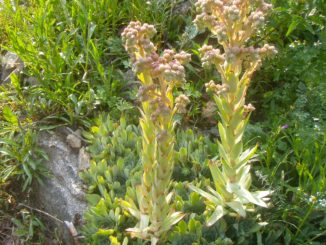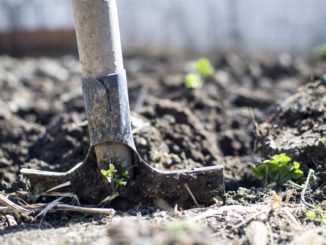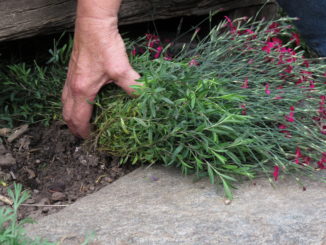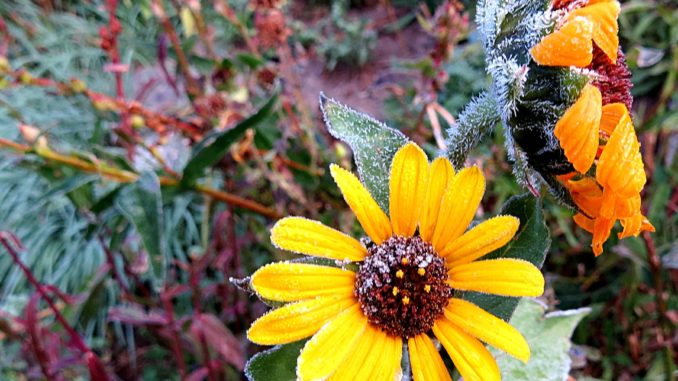
by Sally Roth
North Forty News
Our growing season in northern Colorado is mighty short, especially at higher elevations, like our place at 8100 feet. Somehow, though, I manage to garden just about year-round.
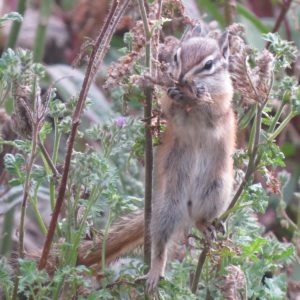
Collecting flower seeds before the chipmunks get them isn’t easy—they know when the seeds are ripe before I do.
Fall is as busy as springtime, with a long to-do list that I never get entirely accomplished. Even better, fall is full of never-failing optimism: Next year, I’m going to have the perfect garden, I just know it!
Spring bulbs are a must. But which beautiful colors of tulips to choose? More mini daffodils, or big classic ‘King Alfred’? Should I even bother planting crocuses, which the doggoned gophers will eat like candy? Of course! Maybe the critters will all move elsewhere by then!
By the time I finally decide which bulbs I want, the early-bird sales are long gone, and even at well-stocked local nurseries, the bins of bulbs have dwindled to mighty slim pickings.
Most savvy gardeners plant bulbs in September and October, when selection is at its peak. Me, I plant in November, because that’s when I finally get around to thinking about them. Or even December, if I can still hack a hole in the ground. Many will be shorter than usual, because they won’t have time to grow good roots before the ground freezes. But bloom they will.
Can’t forget the veggie garden, and, yep, I’m still gardening there, too. When I shop for flower bulbs, I make sure to pick up some garlic, too. I pad out my planting with garlic from the grocery store, just as I do with horseradish roots—which, by the way, it’s time to dig, if you already have a patch.
I sow seeds in fall and winter, too, just like Mother Nature does. Self-sowing flowers are the backbone of my gardens, because who doesn’t want more flowers for free?
I could let them drop their seeds at will, but there’s a problem: My gardens are on a steep hill, and the seedlings move lower every year. So I collect the seeds from the native columbines and asters, the sweet Williams, annual poppies, blue phacelia, and all the others at the bottom of the garden, and scatter them at the top of the hill again.
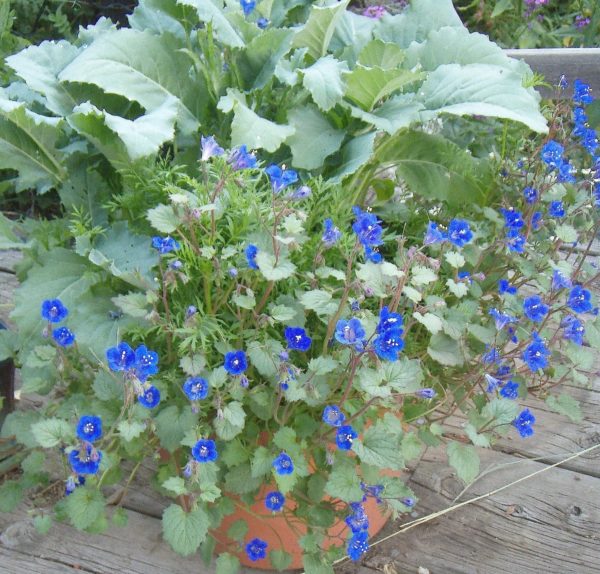
Gorgeous true-blue California bluebells (Phacelia campanularia), a self-sowing desert annual, plants itself all over my gardens. But I collect some seeds in fall to plant where I want them, such as in this pot with kohlrabi.
Not all at once, though, because seed-eating birds are the other problem (darn you, juncos!). So I wait for snow that’s going to last, not melt away the next day—that’s usually December. Then, feeling like old King Midas, I get out my hoard of seeds and scatter them when the snowflakes start to swirl. (Want to learn how to save seeds? See https://northfortynews.com/gardening-why-become-a-seed-saver/)
Frost hit here in August, before I got around to taking cuttings of coleus, sweet potato vines, and begonias, so my windowsills won’t be lined with them this year. But I still have time to do transplanting of young self-sown perennials outside—oh, won’t you look pretty right there!
“Just moved about 200 little plants,” I announced to my husband the other day. “Penstemons, dianthus, flax, blue catmints…”
Hey, it’s only November. I still have a solid month of gardening to go, and maybe even two, before my growing moves indoors. Which reminds me—I need to remember to invest in a couple of red geraniums for the windowsill. They sure boost my spirits during our long winters.
Support Northern Colorado Journalism
Show your support for North Forty News by helping us produce more content. It's a kind and simple gesture that will help us continue to bring more content to you.
BONUS - Donors get a link in their receipt to sign up for our once-per-week instant text messaging alert. Get your e-copy of North Forty News the moment it is released!
Click to Donate

